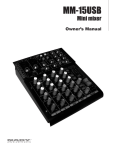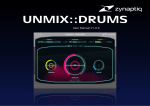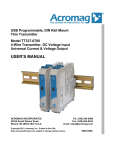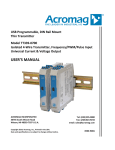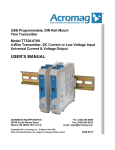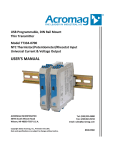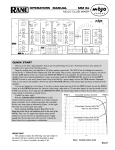Download Nady Systems PMX-420 Music Mixer User Manual
Transcript
OWNER’S MANUAL PMX-420 6 Channel Powered Console Mixer PMX-420 6 Channel Powered Console Mixer Congratulations on your choice of the NADY AUDIO PMX-420 powered console mixer — you have purchased one of the finest powered mixing units on the market today. This unit was developed using the expertise of professional sound engineers and working musicians. You will find that your new PMX-420 powered mixer has superior performance and greater flexibility than any other powered mixer in its price range. Please read this manual carefully to get the most out of your new unit. Thanks for selecting NADY AUDIO as your choice in powered mixers F E AT U R E S • This amazingly compact 6-channel powered mixer can pump out 420W RMS, complete with Echo Effects and Submixes, while capable of handling 11 total inputs simultaneously! • 2 Mono channels each with balanced XLR Mic and 1/4" TRS line inputs and 2 Stereo channels with input A or B selector switch for each channel, Effects Return and Submix 1 & 2 Return with dedicated Volume/Pan for a total of 11 simultaneous inputs • Power Output – 2 x 210W RMS @ 4 ohms (1% THD) with both channels driven. Advanced amplifier design features include fan cooling, short circuit protection, speaker DC protection circuits, clip indicators for utmost safety and reliability and power ON/OFF anti-thump circuit for quietest operation • Stereo L-R Master Mix and S1-2 Group Submix buses, with 4 master faders and submix to main enable switch and Pan controls • Built-in Echo Effects 32-bit DSP emulates plate, gate, room, hall, and stadium reverb • Full complement of input controls, connections and indicators: Channel Trim controls, Peak LED’s, High, Mid, and Low EQ’s; Channel Submix assign and PFL buttons, EFF Send controls, Pan and Volume controls • Effects Send and Return with level control; 2 X 5-segment LED display bargraph meters with L-R/S1-2/EFF and PFL selector and Power Amp peak indicator • Output insert jacks on all L-R and Submix outputs for adding effects or compression before the amplifier • Stereo headphone output with L-R/G1-2/PFL selector and separate volume adjust • Outputs include Line Level Left and Right, Submix 1-2, Low Frequency output, and 1/4" Speaker outputs for Left and Right • Internal shielded AC supply with 115V(60Hz)/230V(50Hz) select switch • Dimension & Weight: 4.5” x 11.4” x 12.3" (114 x 290 x 312mm); 18.8 lbs. (8.5 Kg) CONTENTS FEATURES ................................................................................2 Date of Purchase WARNING ..................................................................................3 INSTALLATION ..........................................................................4 Dealer’s Name 1. Inspection ..............................................................................4 City 2. Setup and Operation ............................................................4 CONTROLS AND CONNECTIONS ............................................5 State 1. Channel Section ....................................................................5 Zip 2. Master and Effects Section ....................................................6 3. Master Input / Output Section ................................................7 Model # 4. Rear Panel..............................................................................8 Serial # CONNECTIONS ........................................................................9 BLOCK DIAGRAM ....................................................................10 SPECIFICATIONS ....................................................................11 2 WA R N I N G IMPORTANT SAFETY INSTRUCTIONS When using this electronic device, basic precautions should always be taken, including the following: 1. Read all instructions before using the product. 2. Do not use this product near water (e.g., near a bathtub, washbowl, kitchen sink, in a wet basement, or near a swimming pool, etc.). 3. This product should be used only with a cart or stand that will keep it level and stable and prevent wobbling. 4. This product, in combination with headphones or speakers, may be capable of producing sound levels that could cause permanent hearing loss. Do not operate for a long period of time at a high volume level or at a level that is uncomfortable. If you experience any hearing loss or ringing in the ears, you should consult an audiologist. 5. The product should be positioned so that proper ventilation is maintained. 6. The product should be located away from heat sources such as radiators, heat vents, or other devices (including amplifiers) that produce heat. 7. The product should be connected to a power supply only of the type described in the operating instructions or as marked on the product. Replace the fuse only with one of the specified type, size, and correct rating. 8. The power supply cord should: (1) be undamaged, (2) never share an outlet or extension cord with other devices so that the outlet’s or extension cord’s power rating is exceeded, and (3) never be left plugged into the outlet when not being used for a long period of time. 9. Care should be taken so that objects do not fall into, and liquids are not spilled through, the enclosure’s openings. 10. The product should be serviced by qualified service personnel if: A. The power supply cord or the plug has been damaged. B. Objects have fallen into, or liquid has been spilled onto the product. C. The product has been exposed to rain. D. The product does not appear to operate normally or exhibits a marked change in performance. E. The product has been dropped, or the enclosure damaged. 11. Do not attempt to service the product beyond what is described in the user maintenance instructions. All other servicing should be referred to qualified service personnel. 3 I N S TA L L AT I O N To ensure years of enjoyment from your NADY AUDIO PMX-420, please read and understand this manual thoroughly before using the unit. INSPECTION Your NADY AUDIO PMX-420 powered mixer was carefully packed at the factory in packaging designed to protect the units in shipment. Before installing and using your unit, carefully examine the packaging and all contents for any signs of physical damage that may have occurred in transit. [Please note: Nady Systems is not responsible for shipping damage. If your unit is damaged, do not return to Nady, but notify your dealer and the shipping company (if shipped to you) immediately to make a claim. Such claims must be made by the consignee in a timely manner.] SETUP AND OPERATION Parts of the unit can become very warm during use. This is normal during operation. Care should be taken to ensure that there is enough space around the unit for cooling. Also, do not place the PMX-420 powered mixer on high temperature devices such as power amplifiers, etc., or the unit may overheat in operation. Although the unit’s chassis is shielded against radio frequency (RF) and electromagnetic interference (EMI), extremely high fields of RF and EMI should be avoided. Please make sure that the power unit supplied is marked for the correct voltage in your area (120VAC/60 Hz or 230VAC/50 Hz). Power requirements for electrical equipment differ from area to area. In new installations and portable sound systems, or any situation in which the AC power is in question, it is wise to confirm the voltage and use the appropriate power supply unit before connecting it to power sources. Europe (except UK): 230V, 50Hz UK and Australia: 240V, 50Hz USA and Canada: 120V, 60 Hz For other areas, please check with local authorities. When ready to operate, plug the AC cord into the power source. Make sure that the unit is turned off before connecting to the AC power source to avoid possible loud transients which can damage your speakers or your ears. Set the Channel (11), Submix (16), and Master Stereo Volume Faders (19) to minimum to further reduce the chance of undesired noise when first powering up. Turn on your PMX-420 powered mixer by pressing on the rear panel Power On/Off Switch (35). 4 CONTROLS AND CONNECTIONS (5) CHANNEL PEAK LED The Peak LED illuminates when a channel input is overloading. (5) It detects the peak level after the Equalizer Controls (6) and (4) will light just before clipping to warn that the signal is approaching overload. You do not want the Peak LED to light except very intermittently. If it lights persistently, reduce the Gain Control (4). If the Gain control is set to minimum, the (6) output level of the preceding equipment should be lowered. (2) (1) (3) (6) EQUALIZER CONTROLS All channels are fitted with a three-band EQ - High, Mid and Low controls. All three bands have up to 15 dB of cut and boost, with a center detent for (7) OFF. The frequency response is flat when all three EQ knobs are in the center detent position. The High and Low (8) shelving controls have their frequencies fixed at 12 KHz and 100Hz respectively and the Mid (9) control is fixed for peak response at 1KHz. The channel EQ is a valuable (11) feature of the mixer as it allows the user to control the tonal characteristics of each channel (10) separately. For example, boosting the Low can fatten the sound, add bass to vocals, or extra punch to bass, drums and synths. The Mid control can be used to increase midrange, fatten guitars, or bring warmth to vocals. Adjusting the High control can provide a crisp sounding high end. Another very important, yet often overlooked technique is to use the EQ to subtract from the mix. Cutting the High control can reduce unwanted sibilance, hiss, cymbals, or high frequency feedback, while attenuating the Mid or Low can also eliminate feedback or clear up a muddy sounding mix. The Mid Freq control can also be used to reduce any feedback. Cutting the High and Low, then pushing up the Channel Volume Control (11) is equivalent to mid range boost! (1) CHANNEL 1 & 2 INPUTS These electronically balanced XLR inputs are designed to accept signals from any balanced or unbalanced low impedance (Low Z) microphone. They can also be used to accept line level signals when the Gain is turned close to minimum. The XLR jack is configured: Pin1 = ground, Pin 2 = positive (+), Pin 3 = negative (-). The 1/4” unbalanced inputs are designed to accept unbalanced Mic or Line level signals such as those from keyboards, drum machines, or samplers. It will be necessary to adjust the input Gain Control (4) to achieve a nominal operating level with no clipping. The Gain Control should be set closer to minimum when using Line level input signals. All four inputs can be used simultaneously to accommodate the use of four audio sources. (2) CHANNEL 3/4 & 5/6 STEREO INPUTS These 1/4” and RCA unbalanced inputs are designed to accept line level signals (max 1V / 2.3dBm) such as those common to CD/tape players, keyboards, direct outputs and home stereo or DJ equipment. Channel 3/4 1/4” inputs can also be used as standard mono line inputs by plugging into the L input only. This signal will be routed equally to the Pan control and the left and right outputs in the same way as the standard line input channels. For each channel there are separate A and B stereo inputs. Either A or B inputs can be selected using the Input Selector Switch. This allows the user to switch to a different input source instantaneously. This is very helpful for DJ when switching to different source material or for musicians who change instruments. (3) INPUT SELECTOR BUTTONS These select either A or B input sources for channels 3/4 and 5/6. [Note: Always reset a channel’s input Gain Control (4) after altering the amount of equalization to avoid input overload.] The key to successful equalization is to avoid excess. Too much equalization on the input channels will result in a mix that is smeared together with nothing specifically defined. During rehearsals, experiment with the equalizer controls on various instruments, vocals and combinations of these mixed together to become familiar with various equalizer settings. (4) GAIN CONTROL The Gain control adjusts the input sensitivity (channel gain) of the inputs. This control can be adjusted to accommodate input signals from a wide variety of sources, from the high outputs of keyboards and drum machines to the small signal outputs of microphones. The best balance of S/N and dynamic range will be achieved if you adjust the Gain control on each channel separately so that the Channel Peak LED (5) almost lights. (7) EFFECTS SEND CONTROL This control adjusts the level of signal sent to the Effects Send 5 CONTROLS AND CONNECTIONS 2. MASTER AND EFFECTS SECTION (23) (24) (13) bus or the internal DSP Echo Effects. The channel Effects Send control is mono, post-EQ, and post-Ch Volume meaning the signal level sent to the Effects Send bus will be affected by the Channel Volume Control (11) setting. For almost all effects send purposes, post-volume is desirable so that when a Ch Volume level is adjusted, any reverb send from that channel follows the volume. Otherwise, when the volume is turned down, the (14) reverb from that channel would still be audible. You can also use this effect send to feed inputs of a multi-track recorder or any other unbalanced line level application. (21) (8) PAN The channel Pan positions the output of the channel in the left/right stereo field of the Master mix and also pans between (12) S1 and S2 in the Submix. Its constantpower design ensures there are no level discrepancies whether a signal is hardpanned, center-stage, or somewhere in- (15) between. (20) (22) (18) (17) (16) (9) SUBMIX 1 & 2 SELECT BUTTON When the Channel S1/S2 button is (8) selected (button depressed), the channel signal is fed to the Submix 1 & 2 bus, controlled by the Submix 1 & 2 (9) Volume Faders (16), as well as the Main Left and Right bus. This signal is post channel Volume and the placement between Sub 1 and Sub 2 is adjusted by (11) the Pan control. The Submix bus offers you a second stereo submix with its own (10) stereo Sub 1 and Sub 2 master faders and Sub outputs. The Submix can be used as a mixing aid both live and in the studio; for example, to combine certain signals to send to a monitor feed, external power amp, or to an external effects processor. It can also be used as a stereo headphone mix if faders are desired for controlling headphone volume. Using the Submix 1 & 2 Send/Return Inserts (29), the Sub signal can be sent out to an external effects processor and then returned into the mixer and mixed onto the Main Left and Right bus allowing these more sensitive faders to adjust the returned signal level. (19) (12) EFFECTS SEND LEVEL CONTROL This control adjusts the final mixed level of the channel Effects Send signals. This signal is then sent to either the internal Echo Effects DSP or the Effects Send Output (27). Plugging into either the Effects Send Output (27) or Effects Return Input (28) jack will automatically disable the internal Echo Effects. The Effects Send signal can be output to an effects processor, multitrack recorder, or used for any other line-level auxiliary purpose, such as monitor feeds. (10) CHANNEL PFL BUTTON This button sends the pre-volume channel signal to the PFL bus for monitoring the input signal with headphones before increasing the channel volume into the mix. (13) ECHO EFFECTS DELAY TIME This rotary wheel can be used to select one of 16 preset time intervals of the built-in Echo Effects DSP between settings 0 - F as shown on the Echo Effects Display (14). Setting 0 - 2 selects the shortest echo time to emulate plate and doubling effects whereas settings 7 - F enables the longest echo time for stadium reverbs and delay sounds. Settings around 3 - 6 emulate room and hall reverbs by adjusting the Repeat Control (15) to approx ten o’clock. (11) CHANNEL VOLUME CONTROL This adjusts the volume level of each channel signal sent to the Effects, Submix, and Main Left & Right. 6 CONTROLS AND CONNECTIONS can be used to maintain proper levels. When set to Main Left & Right, the top red Peak LED will light when the powered output signal is just below clipping. It is acceptable if the red LED lights occasionally. If the red LED lights more than occasionally, you should turn down the Main Left & Right Volume Faders (19) to avoid audible distortion and clipping, which can cause damage to your speakers and even the internal amplifier. (14) ECHO EFFECTS DISPLAY This numeric LED display will indicate which of the 16 echo presets has been selected (0 - F). (15) ECHO EFFECTS REPEAT CONTROL This control adjusts the number of repeats and feedback/depth of the echo effect. Turning the control clockwise sets the repeats to maximum for lengthy stadium echoes or plate effects. Turning the control counter-clockwise sets less repeats for doubling effects. [Caution: Prolonged use at levels above clipping can cause damage to your speakers and even the internal amplifier. Carefully monitor the bargraph meter to avoid prolonged clipping.] The Effects Channel Pan Control (8), Submix 1 & 2 Select Button (9), PFL Button (10), and Channel Volume Control (11) all operate same as the other channels on the internal Echo Effects signal or the Effects Return signal. (22) HEADPHONE SELECT SWITCH This switch is used to set which signal will be sent to the Headphones Output (26). Main Stereo Left & Right signals are sent when set to L - R. When set to S1 - S2, Submix 1 is heard on the left and Submix 2 on the right. The signal of any channel with its PFL Button depressed is heard when the switch is set to PFL. (16) SUBMIX 1 & 2 VOLUME FADERS These faders adjust the level of the Submix 1 & 2 signals that are sent to the Submix 1 & 2 Outputs (30). These faders are post Submix 1 & 2 Send/Return Inserts (29) and will control any signal returning to the PMX-420 via those jacks. The Submix signal can also be selected for the Headphone Output (26) for easy monitoring. The Submix can be a very useful feature if used effectively The Submix can be used as a mixing aid both live and in the studio; for example, to combine certain signals to send to a monitor feed, external power amp, or to an external effects processor. This submix can also be added to the Main/Master mix by depressing the Submix to L-R Enable Buttons (17). (23) POWER LED This LED will illuminate when the unit is switched on. (24) PFL LED This LED will illuminate when any one of the Channel PFL Buttons (10) are switched on. 3. MASTER INPUT / OUTPUT SECTION (30) (32) (33) (34) (35) (17) SUBMIX TO L-R ENABLE BUTTONS When these push-button switches are depressed, the Submix signal is added to the Main/Master bus via the Pan controls. (27) (18) SUBMIX TO L-R PAN CONTROLS With the Submix to L-R Buttons (17) enabled, the Submix can be panned on to the Main Left & Right bus using these controls (19) MAIN LEFT & RIGHT VOLUME FADERS These adjust the final level of the Master Left & Right signals, that are sent to the Main Left & Right (32), Record (34), Low-Pass (33), Headphone (26), and Speaker Stereo Outputs (36). These faders are post Main Left & Right Send/Return Inserts (31) and will affect any signal returning to the PMX-420 via those jacks. (28) (29) (20) LED LEVEL SELECT SWITCH This switch is used to select which signals will illuminate the Dual LED Bargraph Meter (21). Main Stereo Left & Right signals are displayed when set to L - R. When set to S1 - S2, Submix 1 is displayed on the left and Submix 2 is displayed on the right. When set to Effects - PFL, the effects level is displayed on the left bargraph and the PFL level is displayed on the right bargraph. (31) (25) (26) (25) HEADPHONE CONTROL The volume control adjusts the level of the Headphone Output (26). The Headphone Select Switch (22) determines which signal is heard. (26) HEADPHONE OUTPUT The Headphone 1/4” stereo output can be used to monitor the Main, Submix, or PFL signals. Capable of powering headphones with impedances of 8 ohms or greater (21) DUAL LED BARGRAPH METER These 5-stage dual LED meters will display the relative output level of either the Main Left and Right, Submix 1 & 2, or Effects and PFL signals depending on the LED Level Select switch. They (27) EFFECTS SEND OUTPUT 7 CONTROLS AND CONNECTIONS 4. REAR PANEL This mono unbalanced 1/4” jack outputs the channel signals which can be adjusted by the Effects Send Controls (7 & 12). (36) (28) EFFECTS RETURN INPUT This mono unbalanced 1/4” jack enables convenient inputs to the Effects Channel. If you connect a signal to the return jacks, the signal will be routed to the effects Channel Volume Control (11). Plugging into either the Effects Send Output (27) or Effects Return Input (28) jacks will automatically disable the internal Echo Effects. (29) SUBMIX 1 & 2 SEND/RETURN INSERTS These 1/4” TRS insert jacks can be used to send out the Submix signals to an external device and return the signals back via the same jack. They are pre-Sub 1 & 2 fader and allow for routing the signal through external devices such as equalizers, compressors, or effects units. Insert cables must be used for these connections. The wiring for the insert jacks is Tip = Send, Insert Cable Ring = Return. Tip = Send Send (37) (38) (39) (35) POWER ON/OFF SWITCH Use this rocker switch to turn the unit on and off. Ring = Return (36) STEREO SPEAKER OUTPUTS These Left & Right 1/4” speaker outputs can each deliver up to 210W RMS to 4 ohms loads or 150W RMS to 8 ohms loads with both channels driven simultaneously. Return (30) SUBMIX 1 & 2 OUTPUTS These 1/4” jacks output the Submix 1 & 2 unbalanced line level signals. [Caution: Make sure that the speaker, connectors and wiring can handle the rated output power to avoid damage. Note that prolonged use at levels above clipping can drive the amplifier into thermal runaway and damage the internal amplifier and speaker, so care must be taken to not overload the amplifier. Never use less than 4 ohms total impedance for either channel as this can also cause the amplifier to overheat and create thermal runaway.] (31) MAIN LEFT & RIGHT SEND/RETURN INSERTS These 1/4” TRS insert jacks can be used to send out the Main Left & Right signals to an external device and return the signals via the same jack. They are pre-Main Left & Right Volume fader and allow for routing the signal through external devices such as equalizers, compressors, or effects units. Insert cables must be used for these connections. The wiring for the insert jacks is Tip = Send, Ring = Return. (37) POWER CONNECTOR The IEC jack is used to connect the power cord to the AC Power Source. (32) MAIN LEFT & RIGHT OUTPUTS These 1/4” jacks output unbalanced line level signals from the Main Left and Right volume faders. [Caution: Never remove the center grounding pin as this can cause a serious safety hazard and will immediately void your warranty.] (33) LOW-PASS LEFT & RIGHT OUTPUTS These 1/4” jacks output unbalanced line level signals that have been filtered through a Low Pass filter. This output is perfect for feeding directly to an amplifier that powers a subwoofer speaker or to a powered subwoofer with no crossover necessary. The frequency response is 30Hz - 150Hz (-6dB) with a -12dB roll-off point at 250Hz. These signals are post Main Left & Right faders. (38) FUSE COMPARTMENT Replace with only the same type fuse. If the fuse blows continuously, have the unit serviced by qualified personnel. The PMX-420 powered mixer uses 20mm glass tube Fast Blow fuses: 5A 250V for 115VAC, 2.5A 250V for 230VAC. (39) AC VOLTAGE SELECTOR SWITCH Before plugging in the power cord, check to see that the unit is set for the proper voltage for your area: ~115V (60Hz) or ~230V (50Hz). (34) RECORD LEFT & RIGHT OUTPUTS These 1/4” jacks output unbalanced line level signals from the Left and Right bus. These signals are pre Main Left & Right faders. 8 CONNECTIONS 8Ω 8Ω 8Ω 8Ω MONITOR SPEAKERS & POWER AMP REVERB / EFX REVERB / EFX CD PLAYER POWERED SUB TAPE/CD/MP-3 PLAYER PA or RECORDING DEVICE PA or RECORDING DEVICE COMPRESSOR 9 BLOCK DIAGRAM 10 S P E C I F I C AT I O N S 1. INPUTS Input CHANNEL 1-2 CHANNEL 1-2 CHANNEL 3-4 Mono CHANNEL 3-6 STEREO EFFECTS RETURN SUB INSERT RETURNS MAIN INSERT RETURNS Connector Impedance XLR BALANCED 1/4” UNBALANCED 1/4” UNBALANCED 1/4” & RCA UNBALANCED 1/4” UNBALANCED 1/4” UNBALANCED RING 1/4” UNBALANCED RING Sensitivity 10KΩ 5KΩ 4KΩ 8KΩ 22KΩ 7KΩ 5KΩ -60 dBm / 0.7mV -54 dBm / 1.4mV -32 dBm / 20mV -32 dBm / 20mV -27 dBm / 33mV -10 dBm / 240mV 0 dBm / 0.775mV Max Level 0 dBm / 0.775V +4 dBm / 1.2V +2 dBm / 1V +2 dBm / 1V +2 dBm / 1V +5 dBm / 1.4V +5 dBm / 1.4V Sensitivity measured for max power with all volumes at max, EQ’s at mid Maximum Input Level measured with Gain set to min 2. MIXER SECTION Channel High EQ +/-15dB ................................................................................................................................................................12KHz, Rotary control Channel Mid EQ +/-15dB ....................................................................................................................................................................1KHz, Rotary control Channel Low EQ +/-15dB ..................................................................................................................................................................100Hz, Rotary control Channel Gain, Effects Send, Pan, Volume ..................................................................................................................................................Rotary controls PFL, S1-2 Select ................................................................................................................................................................................Push-button switches Echo Effect Time Delay (0 - F) ............................................................................................................................................................6 presets 20-350mS Master and Submix dual faders ...............................................................................................................................................-∞ to +10dB, 50mm sliders 3. MASTER OUTPUT SECTION Channel Input to Main Output Frequency Response........................................................................................................................................................................20Hz~25KHz (+/- 3dB) THD + Noise................................................................................................................................................................................................................0.08% S/N Ratio ........................................................................................................................................................-80dB (gain controls @ mid, faders at 0dB) Noise Floor ......................................................................................................................................................550uV (gain controls @ mid, faders at 0dB) Total Gain. ....................................................................................................................................................................................................................60dB Output Connector Impedance Max Level EFFECTS SEND SUBMIX INSERT SEND SUBMIX 1-2 MAIN L-R INSERT SEND MAIN L-R RECORD L-R LOW PASS L-R30Hz-150Hz 1/4” UNBALANCED 1/4” UNBALANCED TIP 1/4” UNBALANCED 1/4” UNBALANCED TIP 1/4” UNBALANCED 1/4” UNBALANCED 1/4” UNBALANCED 1.5KΩ 150Ω 150Ω 150Ω 200Ω 150Ω 150Ω +16dBm / 5V +10dBm / 2.4V +12Bm / 3V +12Bm / 3V +16dBm / 5V +12Bm / 3V +12Bm / 3V HEADPHONE (w/32Ω load) 1/4” TRS STEREO 32Ω 2 x 20mW 4. POWER OUTPUT SECTION Power Output 8Ω Both Channels Driven (1% THD) ..............................................................................................................................................150W RMS per side 4Ω Both Channels Driven (1% THD) ..............................................................................................................................................210W RMS per side Channel Input to Speaker Output Frequency Response ..................................................................................................................................................................20Hz~22KHz (+/- 3dB) THD........................................................................................................................................................................................................................0.07% S/N Ratio ........................................................................................................................................................-74dB (gain controls @ mid, faders at 0) Noise Floor ....................................................................................................................................................6.2mV (gain controls @ mid, faders at 0) Total Gain ................................................................................................................................................................................................................94dB Amplifier Protection ............................................Fan cooling, short circuit protection, DC protection circuits, clip LED indicators, Power ON/OFF relays 5. GENERAL Power Requirements ..........................................................................................................................Voltage selectable, 115VAC/60Hz or 230VAC /50Hz Fuse Requirements ......................................................................................................................................5x20mm glass tube F.B. 5A 250V @ 115VAC 2.5A 250V @ 230VAC Weight ...................................................................................................................................................................................................... 18.8 lbs. (8.5 Kg) Dimensions (HWD) ..............................................................................................................................................4.5” x 11.4” x 12.3” (114 x 290 x 312mm) The specifications above are correct at the time of printing of this manual. For improvement purposes, all specifications for this unit, including design and appearance, are subject to change without prior notice. 11 SERVICE FOR YOUR NADY AUDIO PRODUCT (U.S.) Should your NADY AUDIO product require service, please contact the Nady Service Department via telephone at (510) 652-2411, or e-mail at [email protected]. (International) For service, please contact the NADY AUDIO distributor in your country through the dealer from whom you purchased this product. DO NOT ATTEMPT TO SERVICE THIS UNIT YOURSELF AS IT CAN BE DANGEROUS AND WILL ALSO VOID THE WARRANTY. NADY SYSTEMS, INC. • 6701 SHELLMOUND STREET, EMERYVILLE, CA 94608 Tel: 510.652.2411 • Fax: 510.652.5075 • nady.com












